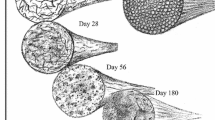Abstract
One of the defining properties of biological structural materials is self-healing, i.e., the ability to undergo long-term reparation after instantaneous damaging events, but also after microdamage due to repeated load cycling. To correctly model the fatigue life of such materials, self-healing must be included in fracture and fatigue laws, and related codes. Here, we adopt a numerical modelization of fatigue cycling of self-healing biological materials based on the hierarchical fiber bundle model and propose modifications in Griffith’s and Paris’ laws to account for the presence of self-healing. Simulations allow us to numerically verify these modified expressions and highlight the effect of the self-healing rate, in particular, for collagen-based materials such as human tendons and ligaments. The study highlights the effectiveness of the self healing process even for small healing rates and provides the possibility of improving the reliability of predictions of fatigue life in biomechanics, e.g., in sports medicine.









Similar content being viewed by others
References
M.A. Meyers, P-Y. Chen, A.Y-M. Lin, and Y. Seki: Biological materials: Structure and mechanical properties. Prog. Mater. Sci. 53(1), 1 (2008).
B.A. Winkelstein: Orthopaedic Biomechanics (CRC Press, Boca Raton, FL, 2013).
M.A. Meyers, J. McKittrick, and P-Y. Chen: Structural biological materials: Critical mechanics-materials connections. Science 339(6121), 773 (2013).
S.R. White, N.R. Sottos, P.H. Geubelle, J.S. Moore, M.R. Kessler, S.R. Sriram, E.N. Brown, and S. Viswanathan: Autonomic healing of polymer composites. Nature 409(6822), 794 (2001).
V. Sahni, J. Harris, T.A. Blackledge, and A. Dhinojwala: Cobweb-weaving spiders produce different attachment discs for locomotion and prey capture. Nat. Commun. 3, 1106 (2012).
K.S. Toohey, N.R. Sottos, J.A. Lewis, J.S. Moore, and S.R. White: Self-healing materials with microvascular networks. Nat. Mater. 6(8), 581 (2007).
C.J. Hansen, W. Wu, K.S. Toohey, N.R. Sottos, S.R. White, and J.A. Lewis: Self-healing materials with interpenetrating microvascular networks. Adv. Mater. 21(41), 4143 (2009).
E.N. Brown, S.R. White, and N.R. Sottos: Retardation and repair of fatigue cracks in a microcapsule toughened epoxy composite—Part II: In situ self-healing. Compos. Sci. Technol. 65(15–16), 2474 (2005).
P. Cordier, F. Tournilhac, C. Soulie-Ziakovic, and L. Leibler: Self-healing and thermoreversible rubber from supramolecular assembly. Nature 451(7181), 977 (2008).
E.N. Brown, S.R. White, and N.R. Sottos: Retardation and repair of fatigue cracks in a microcapsule toughened epoxy composite—Part I: Manual infiltration. Compos. Sci. Technolo. 65(15–16), 2466 (2005).
A.S. Jones, J.D. Rule, J.S. Moore, N.R. Sottos, and S.R. White: Life extension of self-healing polymers with rapidly growing fatigue cracks. J. R. Soc., Interface 4(13), 395 (2007).
E.B. Murphy and F. Wudl: The world of smart healable materials. Prog. Polym. Sci. 35(1–2), 223 (2010).
A.C. BaLazs: Modelling self-healing materials. Mater. Today 10(9), 18 (2007).
A. Gautieri, S. Vesentini, A. Redaelli, and M.J. Buehler: Hierarchical structure and nanomechanics of collagen microfibrils from the atomistic scale up. Nano Lett. 11(2), 757 (2011).
S. Pradhan, A. Hansen, and B.K. Chakrabarti: Failure processes in elastic fiber bundles. Rev. Mod. Phys. 82(1), 499 (2010).
N.M. Pugno, F. Bosia, and A. Carpinteri: Multiscale stochastic simulations for tensile testing of nanotube-based macroscopic cables. Small 4(8), 1044 (2008).
F. Bosia, T. Abdalrahman, and N.M. Pugno: Investigating the role of hierarchy on the strength of composite materials: Evidence of a crucial synergy between hierarchy and material mixing. Nanoscale 4(4), 1200 (2012).
F. Bosia, T. Abdalrahman, and N.M. Pugno: Self-healing of hierarchical materials. Langmuir 30(4), 1123 (2014).
H. Schechtman and D.L. Bader: In vitro fatigue of human tendons. J. Biomech. 30(8), 829 (1997).
H. Schechtman and D.L. Bader: Fatigue damage of human tendons. J. Biomech. 35(3), 347 (2002).
T.A.L. Wren, S.A. Yerby, G.S. Beaupré, and D.R. Carter: Mechanical properties of the human achilles tendon. Clin. Biomech. 16(3), 245 (2001).
T.L. Anderson: Fracture Mechanics: Fundamentals and Applications, 3rd ed. (Taylor & Francis, Boca Raton, FL, 2005).
N. Pugno, A. Carpinteri, M. Ippolito, A. Mattoni, and L. Colombo: Atomistic fracture: QFM vs. MD. Eng. Fract. Mech. 75(7), 1794 (2008).
M.G.P.C. Paris and W.E. Anderson: A rational analytic theory of fatigue. Trend Eng. 13, 9 (1961).
N. Pugno, P. Cornetti, and A. Carpinteri: New unified laws in fatigue: From the Wohler’s to the Paris’ regime. Eng. Fract. Mech. 74(4), 595 (2007).
N. Pugno, M. Ciavarella, P. Cornetti, and A. Carpinteri: A generalized Paris’ law for fatigue crack growth. J. Mech. Phys. Solids 54, 1333–1349 (2006).
R. Lakes: Materials with structural hierarchy. Nature 361(6412), 511 (1993).
P. Fratzl and R. Weinkamer: Nature’s hierarchical materials. Prog. Mater. Sci. 52(8), 1263 (2007).
W. Weibull: A Statistical Theory of the Strength of Materials, Ingeniörsvetenskapsakademiens Handlingar Nr 151, 1939 (Generalstabens Litografiska Anstalts Förlag, Stockholm).
R.K. Nalla, J.J. Kruzic, J.H. Kinney, and R.O. Ritchie: Aspects of in vitro fatigue in human cortical bone: time and cycle dependent crack growth. Biomaterials 26, 2183–2195 (2005).
K.J. Mach, B.B. Hale, M.W. Denny, and D.V. Nelson: Death by small forces: a fracture and fatigue analysis of wave-swept macroalgae. J. of Exp. Biology 210, 2231–2243.
P. Fratzl: Collagen: Structure and Mechanics (Springer, 2008).
ACKNOWLEDGEMENTS
NMP acknowledges support from the European Research Council, ERC Ideas Starting Grant No. 279985 “BIHSNAM”, from ERC Proof of Concept Grant No. 619448 “REPLICA2” and No. 632277 “KNOTOUGH”, from the Graphene FET Flagship (“Graphene-Based Revolutions in ICT And Beyond”-Grant agreement No. 604391), and from the Autonomous Province of Trento (Graphene PAT WP10, code 81017). FB acknowledges support from BIHSNAM. The authors also acknowledge support for computational resources from Politecnico di Torino’s DAUIN High Performance Computing Initiative (www.dauin-hpc.polito.it).
Author information
Authors and Affiliations
Corresponding author
Additional information
This author was an editor of this focus issue during the review and decision stage. For the JMR policy on review and publication of manuscripts authored by editors, please refer to http://www.mrs.org/jmr-editor-manuscripts/.
Rights and permissions
About this article
Cite this article
Bosia, F., Merlino, M. & Pugno, N.M. Fatigue of self-healing hierarchical soft nanomaterials: The case study of the tendon in sportsmen. Journal of Materials Research 30, 2–9 (2015). https://doi.org/10.1557/jmr.2014.335
Received:
Accepted:
Published:
Issue Date:
DOI: https://doi.org/10.1557/jmr.2014.335




